Characteristics
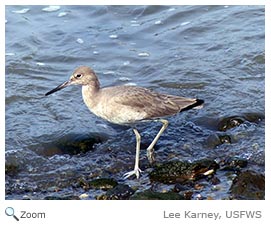 The willet is a large shorebird that is a member of the sandpiper family. It is about 13-15 inches in length. It has a grayish-brown head, back, and wings; a white belly; a long, straight black bill; long grayish-blue legs and black and white bands on its wings that are visible when it is flight. Males and female look alike, but the female is a little larger. The willet is a large shorebird that is a member of the sandpiper family. It is about 13-15 inches in length. It has a grayish-brown head, back, and wings; a white belly; a long, straight black bill; long grayish-blue legs and black and white bands on its wings that are visible when it is flight. Males and female look alike, but the female is a little larger.
Range
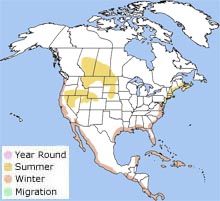 The willet
breeds from central Canada to northeastern California and Nevada and along the Atlantic and Gulf Coasts south from Nova Scotia. It winters along the Pacific Coast from Oregon south and along the Atlantic Coast from North Carolina southward to northern South America. The willet
breeds from central Canada to northeastern California and Nevada and along the Atlantic and Gulf Coasts south from Nova Scotia. It winters along the Pacific Coast from Oregon south and along the Atlantic Coast from North Carolina southward to northern South America.
Habitat
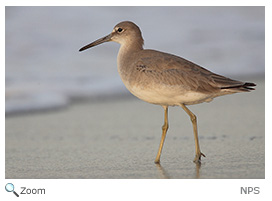 The willet
live on coastal beaches, freshwater and salt marshes, lakeshores, mudflats and wet prairies. The willet
live on coastal beaches, freshwater and salt marshes, lakeshores, mudflats and wet prairies.
Diet
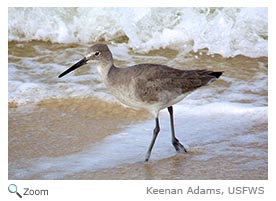 The willet forages in mudflats, intertidal areas, and shallow marsh waters and snatches up food from the surface of the water, or it probes in the mud with its long bill. It often wades up to its belly in the water searching for food. It eats
aquatic insects, marine worms, small crabs, small mollusks, and fish. Its diet also includes plant matter like grass and seeds. The willet forages in mudflats, intertidal areas, and shallow marsh waters and snatches up food from the surface of the water, or it probes in the mud with its long bill. It often wades up to its belly in the water searching for food. It eats
aquatic insects, marine worms, small crabs, small mollusks, and fish. Its diet also includes plant matter like grass and seeds.
|
|
Life Cycle
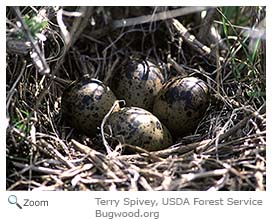 The willet often nests in colonies. The female chooses a nesting site in a
well-hidden location. She lays
4 eggs in April or May in a depression in the ground or in a clump of grass that is lined with weeds or pieces of shell. Both parents incubate the eggs for 22-29 days.
The chicks are
precocial and feed themselves shortly after birth. Both parents care for the chicks. The female will leave when the chicks are 2-3 weeks old. The male will stay with the chicks until they fledge at about 4 weeks old. The willet often nests in colonies. The female chooses a nesting site in a
well-hidden location. She lays
4 eggs in April or May in a depression in the ground or in a clump of grass that is lined with weeds or pieces of shell. Both parents incubate the eggs for 22-29 days.
The chicks are
precocial and feed themselves shortly after birth. Both parents care for the chicks. The female will leave when the chicks are 2-3 weeks old. The male will stay with the chicks until they fledge at about 4 weeks old.
Behavior
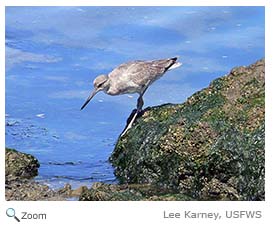 Willets are very territorial and will aggressively defend their nesting and feeding territory. The willet is a very
noisy bird and will call out with a
pill-will-willet pill-will-willet when disturbed. It will fly overhead and and continue calling out until the threat goes away. It often perches on bushes, trees, fenceposts, or rocks. Willets are very territorial and will aggressively defend their nesting and feeding territory. The willet is a very
noisy bird and will call out with a
pill-will-willet pill-will-willet when disturbed. It will fly overhead and and continue calling out until the threat goes away. It often perches on bushes, trees, fenceposts, or rocks.
|